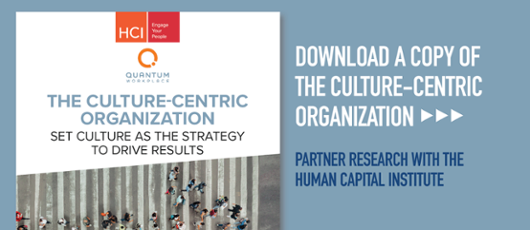Why is Organizational Culture Important? [Original Research & Tips]
Unpacking organizational culture
Company culture has become a top priority for leaders across all industries. In fact, 66% of executives believe culture is more important than an organization's business strategy or operation model.
The rise of remote and hybrid work has had a significant impact on the way we work. Our research shows 65% of employees say their company culture has changed since the start of the COVID-19 pandemic. As the workplace has changed, culture has too—for better or for worse.
Those organizations that have adapted their approach to culture have fared well over the past few years. They've created an attractive value proposition for prospective talent and have kept current employees engaged—even through periods of significant change. Those who have been slower to evolve have seen consequences of disengagement, burnout, and unwanted turnover.
Our research shows disengaged employees are 3.8 times more likely than their engaged counterparts to cite organizational culture as a reason for leaving.
While most leaders agree a strong culture is key to business success, many have different ideas about what culture really is. This lack of clarity makes it difficult to make changes that move the needle. Leaders need to take a good look at the role culture plays in attracting, retaining, engaging, and empowering talent. They need to focus on the aspects of culture that drive employee, team, and business success.
Our organizational culture research offers a fresh perspective on workplace culture. It helps make clear the most critical aspects of creating an engaging and successful culture. It shows the link between culture, employee engagement, and retention. And it will help organizational leaders rethink their approach to culture in order to shape a foundation for business success.
What is organizational culture?
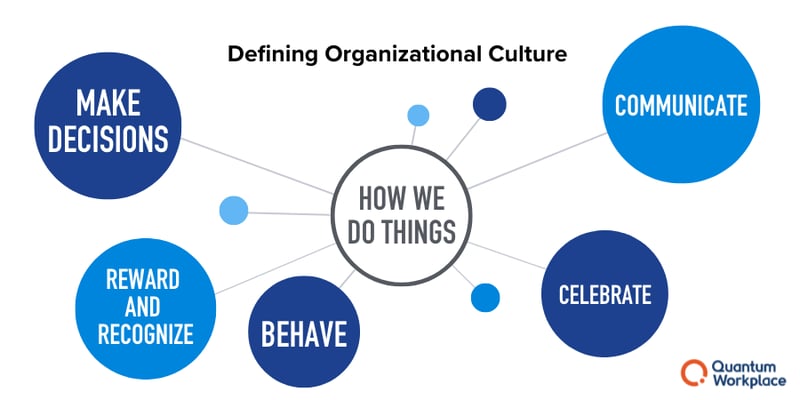
Culture has been historically defined as organizational norms, rituals, and values. But organizational culture is so much more than that. It’s about the day-to-day attitudes, actions, and behaviors at an organization. Essentially, it’s how work gets done within a business, including:
- The way you make decisions
- The way you communicate
- The way you celebrate employees
- The way you behave
- The way you reward and recognize others
The top elements of organizational culture
Employees experience culture through many aspects of your organization. But our research shows that some aspects are felt much more powerfully than others. Culture is really about the day-to-day details of how work gets done. Here are the top ways that employees feel the culture at their organization.
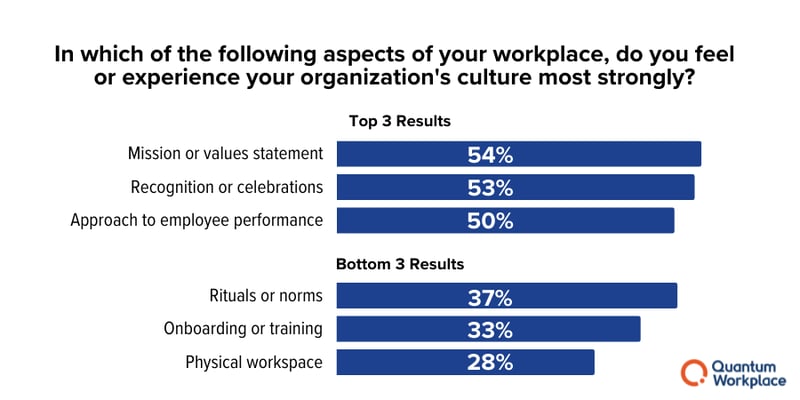
50% of employees experience culture most strongly in their organization's approach to employee performance.
The way you manage performance has a strong impact on engagement and organizational culture. How managers create alignment, communicate, recognize, and give feedback all shape an employee’s experience. Focus on performance management approaches that drive employee success and wellbeing.
Read our research on creating an engaging performance management approach here >>
53% of employees feel culture most strongly through recognition and celebrations.
Employees want to feel valued for their contributions. How you recognize individuals and teams says a lot about your culture and what you value. When you publicly recognize employees for behaviors that align with your culture and values, it helps bring culture to life.
54% of employees experience culture most strongly through their organization's mission and values.
Your mission and values set the tone for how work gets done. If your mission is to help others, your culture might be more collaborative. If innovation is a core value, put systems in place that encourage innovation. To create a strong culture, leverage your mission and values to guide everyday initiatives.
What employees think about organizational culture
Company culture is changing across all industries. Our research shows that while some employees believe this change is positive, others think differently. As culture continues to evolve, it impacts the employee experience in different ways than before.
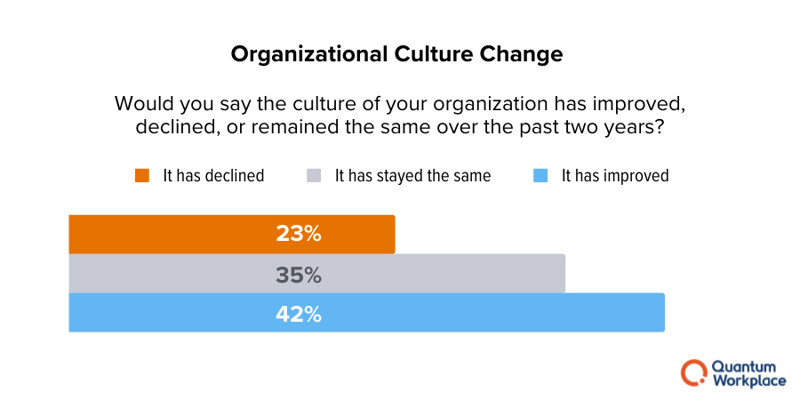
65% of employees say their company's culture has changed post-pandemic.
35% say their culture has changed dramatically. As the workplace has changed, culture has changed too—for better or worse. Whether or not you’re actively investing in your culture, someone or something is shaping it. Leaders must keep a pulse on culture to ensure they’re driving the right changes at the right times.
2 in 3 employees say their organizational culture is "very positive."
Many organizations have successfully adapted their cultures to remote and hybrid work. However, 1 in 3 employees have neutral or negative perceptions of their organization’s culture—a number that is hard to swallow considering the connection between culture, engagement, and turnover. 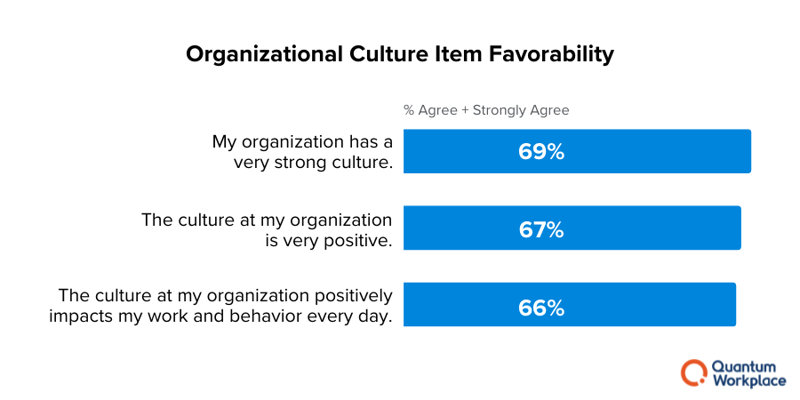
66% of employees say their culture positively impacts their work and behavior everyday.
Culture is a day by day, moment by moment experience. It’s key to create a culture that promotes the right outcomes and behaviors. Listen to what your employees have to say about the day to day happenings inside your organization—and make adjustments that improve their experience.
How culture impacts employee engagement & retention risk
Culture—or “how work gets done”—is going to look different in your unique workplace. The way you communicate, treat each other, and make decisions can either positively impact engagement and retention, negatively impact it, or not impact it at all.
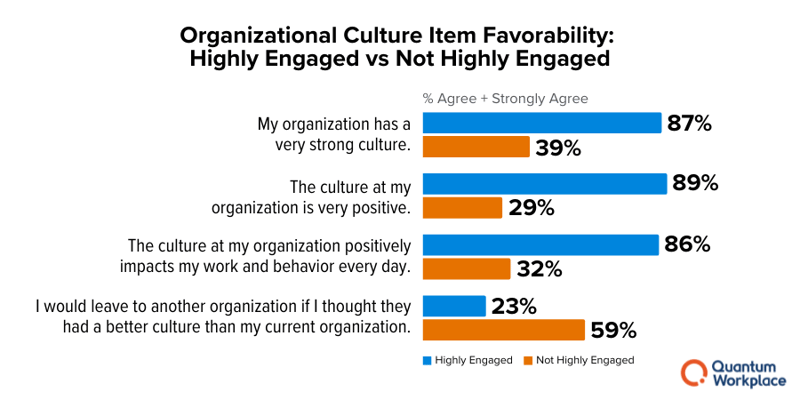
Employees who say their culture is positive are 3.8x more likely to be engaged.
A positive culture strengthens employee engagement. When employees agree that their organizational cultures are positive, they are more likely to be highly engaged, (84%) than those who do not agree (22%).
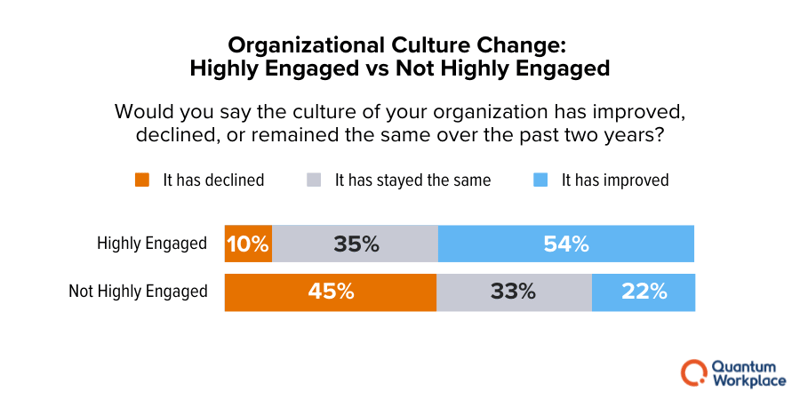
Employees who say their culture has improved since the pandemic are 2.9x more likely to be highly engaged.
When employees say their culture has improved over the past two years, they are more likely to be highly engaged (81%) than employees who say it has declined (28%). This illustrates the link between culture and engagement. A strong culture drives employee engagement, whereas a weak culture can boost disengagement.
Disengaged employees are 2.6x more likely to leave their company for a better culture.
Roughly 60% of disengaged employees—and only 23% of engaged employees—would leave their company for a better culture. This suggests that employee engagement is the motivating factor behind retention. One of the ways to drive engagement? A positive workplace culture.
Where organizational culture thrives
Remote and hybrid work environments are becoming the norm. While many leaders believe that culture suffers outside of the physical workplace, our research provides a different perspective. Those offered flexibility in the workplace are likely to see culture more favorably.
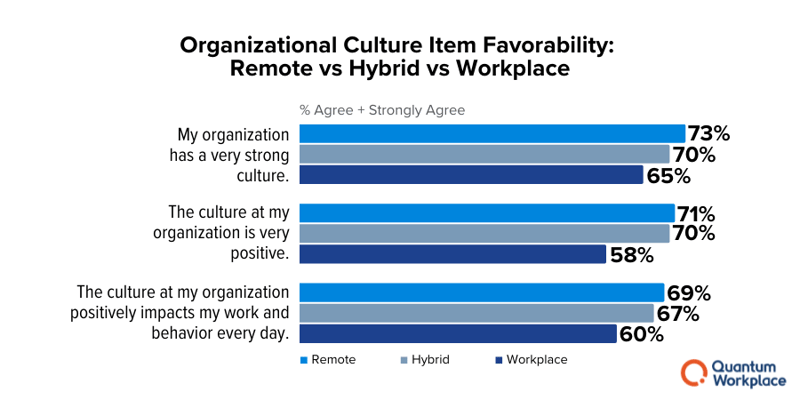
Remote/hybrid employees are more likely to report a strong and positive company culture.
Only 65% of on-site employees believe their company has a strong culture, compared to over 70% of remote and hybrid workers. Only 58% of onsite employees say their culture is positive, compared to roughly 70% of remote and hybrid employees. Company culture isn’t attached to the physical workplace. In fact, it can be strengthened in a remote/hybrid environment. Giving employees the option to choose where they work fosters a culture of mutual trust and respect.
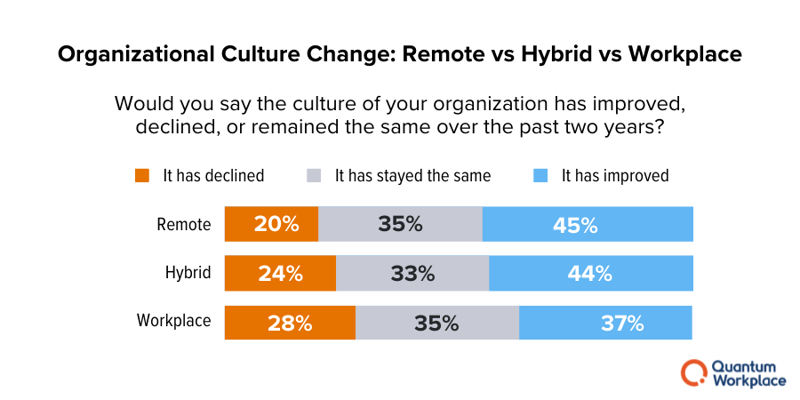
Remote/hybrid employees are more likely to say their culture has improved.
While remote (45%) and hybrid (44%) say their cultures have improved, only 37% of on-site employees say the same. Flexible work arrangements promote employee wellbeing, autonomy, work-life balance, inclusion and productivity.
Workplace employees are most likely to say their culture has declined.
28% of on-site workers say their culture has declined since the start of the pandemic. Now more than ever, employees expect flexibility, autonomy, and trust. When you can’t give your employees the option to work from home, try to find other ways for them to decide how their work gets done.
A Note on Industry Impact
There are some industries and roles that are inherently less conducive to remote/hybrid work arrangements. Therefore, we explored whether other factors, like industry or company size, influence employees' perceptions of culture. While industry and company size can impact these perceptions, we found that where and how employees work has a stronger influence on their perceptions of culture. Regardless of the type of work you do, employees want a culture of flexibility and trust. That's why culture doesn't fizzle out in flexible or non-traditional work environments.
What employees want in an organizational culture
Engaged and disengaged employees describe their cultures in different ways. But both engaged and disengaged employees know what they want—and don’t want—when it comes to culture.
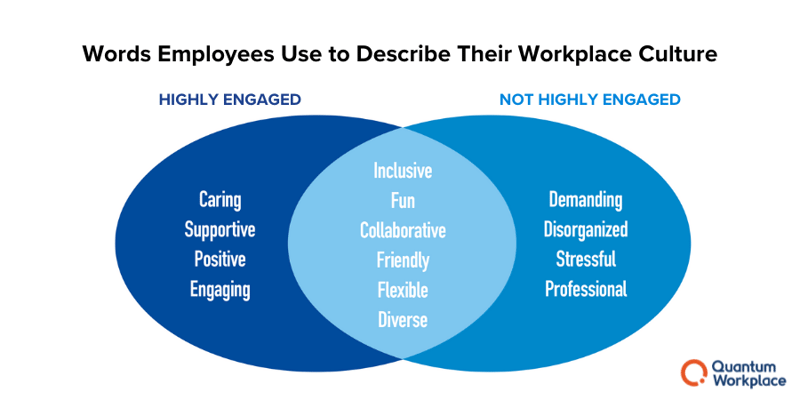
No surprises here. Engaging cultures have a better reputation with talent.
It’s no surprise that engaged employees value their culture. After all, culture is a key factor behind engagement. The top words engaged employees use to describe their culture are:
- Inclusive
- Caring
- Supportive
- Fun
- Collaborative
But disengaged employees have different thoughts. A few words disengaged employees use to describe their culture include:
- Demanding
- Disorganized
- Stressful
- Professional
How employees describe an ideal culture
Regardless of engagement level, employees know what they want when it comes to culture. The top 5 words employees used to describe an ideal culture are:
1. Flexible
2. Inclusive
3. Supportive
4. Collaborative
5. Caring
To engage your employees, give them the flexibility to decide how, when, and where their work gets done. You should also prioritize inclusivity and give everyone the opportunity to succeed regardless of role, tenure or background. Regular check-ins, growth-focused coaching, and collaboration will support employee success further. Finally, ensure you show your people that you care about them as humans—not just employees.
Who shapes organizational culture?
According to our research, employees believe leaders, managers, and HR are responsible for company culture. But to create a great culture, everyone needs to play a part. Culture should grow and evolve in a way that resonates with each employee, regardless of role.
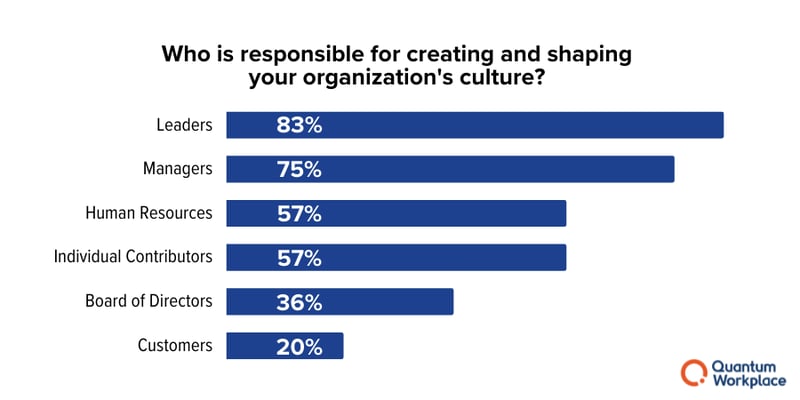
Employees believe that leaders and managers are responsible for culture.
Culture starts at the top. In fact, Leaders should clearly define culture, communicate about it regularly, set a good example, and tie business outcomes to company values. This will empower employees to practice, develop, and evolve cultural norms.
57% of employees believe HR is responsible for creating company culture.
Many employees expect HR to shape company culture. But while HR is probably trying to create culture, they need leadership and employees to support their efforts. Without company-wide adoption, you won’t see the culture change you want.
57% of employees believe individual contributors are responsible for shaping culture.
Each individual plays a part in culture. To create a strong culture, employees must understand and live out their culture, mission, and values. They must collaborate, recognize, communicate, and behave in a way that aligns with cultural norms.
Everyone plays a part in culture. The healthiest cultures are shaped by every person within an organization. And the job of creating culture is never done. As your organization changes, it’s important to be intentional about how those changes impact culture.
5 tips for creating a strong, engaging culture
A healthy culture looks different for everyone. Leaders should keep their unique business problems and opportunities in mind when creating a culture strategy. Shape your approach with these tips to foster a culture of engagement, performance, and long-term success.
1. Aim your culture strategies at engagement.
A healthy culture drives employee engagement first and foremost. When you evaluate “how work gets done” at your organization, try to understand how each aspect could impact employee engagement. Engagement is all about connecting employees to their work, team, and organization—ensure your culture strategies do the same.
2. Evolve your approach to employee performance.
Employees say performance management is a key component of culture. With the right practices, you can drive alignment, motivation, growth, and engagement. With the wrong approach, you risk toxicity, distrust, and burnout. Use performance management as a tool to strengthen culture with continuous feedback, effective communication, company-wide alignment, and fairness and transparency.
3. Focus on driving trust-building leadership practices.
To create a culture of trust, clearly outline your organization’s vision, strategy, progress, and goals. Leaders should communicate frequently and transparently to prevent employee confusion or resentment when change happens. Continue this communication when you gather employee feedback too, explaining how feedback was used—or why it wasn’t. Finally, allow employees to see leaders as real people—genuine relationships are needed to foster genuine trust.
4. Weave employee recognition into all that you do.
Recognition happens in the way you communicate, promote, compensate, assign work, and provide opportunities. Build a system that recognizes behaviors critical to your organizational culture. You should prioritize authenticity when you recognize employees and tailor your communication to each individual. Employee recognition should happen every day—a simple thank you goes a long way.
5. Invest in tech that helps you see, understand, and act on culture.
A robust employee engagement, performance, and people analytics platform will outline the big picture behind your culture and help you understand where to focus and when. With the right tools, you can uncover deep insights, measure employee perceptions, and create a thriving culture.
Make culture easier with Quantum Workplace
Every employee in the company builds culture. That's why it's crucial for every aspect of your business to intentionally reflect the culture you want your organization to have.
Employee success tools and technology make it easy for your employees to contribute positively to your culture in their day-to-day tasks, goals, communication, and celebrations.
We make it easy to grow, develop, and retain your best talent.
Lack of career growth and development is one of the primary reasons employees leave their organization. Employees don’t want to feel stagnant. If they do, the result is a lack of engagement and impact. It is crucial to leverage tools that help managers and employees map and track development together.
We make it easy to connect and celebrate meaningfully.
Your culture comes to life through the ways you celebrate and recognize your employees. Building a culture of connection and appreciation centered around your organization’s core values not only boosts employee morale, but also engagement and impact.
We make it easy to predict and prevent turnover.
You need to take a targeted approach to analyzing turnover and retention. To move from reacting to turnover to proactively addressing it, you have to understand what drives top talent to leave and continuously implement strategies to retain your best employees.
We make it easy to stand out and compete for talent.
Employees are your most vital asset. You need to have a dynamic strategy in place to stand out against your competitors and attract top talent. Benchmarking can help you understand the strengths and opportunities of your employee value proposition compared to your competitors. Transform your EVP into one that cannot be imitated.
Survey Methodology
The research from this report was derived from the Best Places to Work contest—powered by Quantum Workplace. This nationwide contest measures the employee experience of over 1 million voices across thousands of the most successful organizations in the United States.
From this respondent pool, we conduct an opt-in, independent research panel with over 32,000 individuals who share their workplace experiences. This unique vantage point gives us the ability to understand workplace trends to supply insights that help other organizations succeed.
Learn how to build a magnetic culture by making culture easier for you and your teams!


![Why is Organizational Culture Important? [Original Research & Tips]](https://www.quantumworkplace.com/hubfs/Culture%20Report%20-%20HRE%20Ad%20LP%20-%20052022%20(400%20%C3%97%20400%20px)%20(1200%20%C3%97%201000%20px).png)

